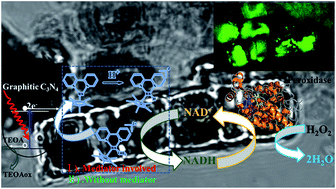Jian Liu and Markus Antonietti, of the Max Planck Institute of Colloids and Interfaces, have made a significant advance in carbon nitride photocatalysis. They impressively demonstrate the use of a bioinspired photosynthetic membrane in the photocatalytic regeneration of NADH without an electron mediator in their recent EES Communication.
The authors constructed their artificial photosynthesis system from a green and sustainable material called diatomite by an “incipient wetness impregnation” method. The graphitic carbon nitride photocatalyst was designed with a diatom frustule structure that imitates diatoms, which are unicellular photosynthetic organisms responsible for around one-fifth of the global photosynthesis yield.
Interest in applying enzymes for organic synthesis is increasing, due to their high efficiency and regioselectivity. However, enzyme-specific co-factors are costly and the procedure of enzyme-catalysed regeneration of NAD(P)H is complicated. An efficient and sustainable method for the regeneration of NADH is vital. Photosystem I, an integral membrane protein complex, uses light energy to mediate electron transfer for the reduction of NADP to NADPH, storing the light energy in chemical “currency”. Imitating the function of Photosystem I is very promising, cost effective and inherently sustainable.
Read this exciting Communication today:
Bio-inspired NADH regeneration by carbon nitride photocatalysis using diatom templates
Jian Liu and Markus Antonietti
DOI: 10.1039/C3EE40696B











